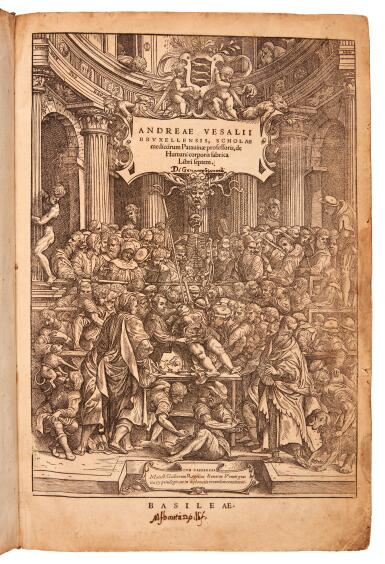Books, Manuscripts and Music from Medieval to Modern
Books, Manuscripts and Music from Medieval to Modern

Andreas Vesalius | De humani corporis fabrica libri septem, Basel, 1543, the Royal Institution copy
Lot closes
July 11, 11:55 AM GMT
Estimate
200,000 - 300,000 GBP
Starting Bid
200,000 GBP
Lot Details
Description
Andreas Vesalius
De humani corporis fabrica libri septem. Basel: Johannes Oporinus, June 1543
FIRST EDITION, folio (411 x 278mm), Roman, italic, Hebrew and Greek types, woodcut title-page depicting the author in a crowded lecture hall dissecting a cadaver, woodcut portrait of Vesalius (aged 28) with a dissected arm on *6v, woodcut initials, over 200 woodcut illustrations, including 3 full-page skeletons and 14 full-page “muscle-men”, woodcut and letterpress double-sided folding plate at m3, with another folding sheet signed m3, woodcut and letterpress folding plate at p4, woodcut printer's device on final verso, old (probably eighteenth century) vellum, clamshell collector’s case, Q1 with four-inch closed tear extending into printed area, S2 and following four leaves with slight worming at upper margins, a few leaves slightly browned, binding slightly soiled, slightly worn at joints, spine darkened
First edition, with distinguished provenance, of this "epochal publication, one of the most beautiful scientific books ever printed"(Grolier/Horblit). This publication revolutionized the study and teaching of anatomy; because of Vesalius's insistence on empirical observation, it "undermined the widespread reverence for authority in science and prepared the way for independent observation in anatomy and clinical medicine" (Garrison-Morton). Vesalius studied medicine at the University of Paris and received his doctorate in medicine from the University of Padua in 1537. There he lectured on surgery and anatomy, beginning his practice of performing dissections himself while conducting his lectures instead of assigning a barber-surgeon that function. Shortly thereafter, a judge of the Paduan criminal court made available to Vesalius the bodies of executed criminals, which provided him with sufficient specimens to produce, at the age of twenty-nine, his monumental anatomical study. The importance of the Fabrica in the history of medicine can scarcely be exaggerated. His remarkably accurate text is coupled with woodcut anatomical illustrations of artistic and technical brilliance in a comprehensive study of bones, muscles, blood vessels, nerves, abdominal viscera, thoracic organs and the brain. "Galen was not merely improved upon: he was superseded; and the history of anatomy is divided into two periods, pre-Vesalian and post-Vesalian" (PMM).
REFERENCES: Dibner, Heralds of Science 122; Garrison-Morton 375; Heirs of Hippocrates 281; Grolier, Medicine 18A; Magócsy, Somos and Joffe, The Fabrica of Andreas Vesalius, a worldwide census, I/A4; NLM/Durling 4577; Norman 2137; PMM 71
PROVENANCE:
1. Alberto Lollio (b. 1508; noted humanist scholar from Ferrara member of the Accademia degli Elevati, which championed Tuscan literature), partly obscured signature at foot of title-page
2. Gennaro Giannelli (eighteenth-century Neapolitan physician and bibliophile), signature on title-page
3. Martin Tupper, FRS, FGS (1780–1844; physician to the Duke of Wellington), engraved armorial bookplate; bequeathed to
4. The Royal Institution (founded 1799), deaccession label on rear paste-down, sale, Christie’s, 1 December 2015, lot 284, £254,500
